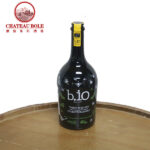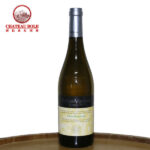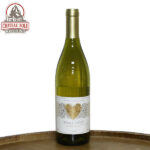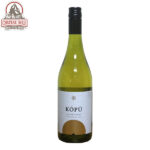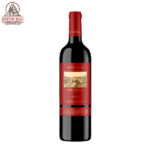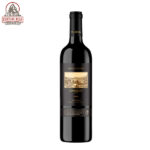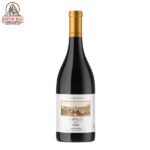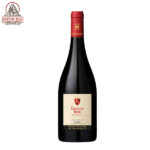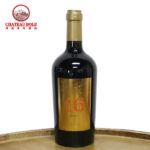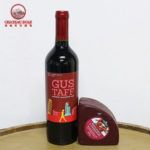Chardonnay
Chardonnay (pronounced [ʃaʁ.dɔ.nɛ]) is a green-skinned grape variety used in the production of white wine. The variety originated in the Burgundy wine region of eastern France, but is now grown wherever wine is produced, from England to New Zealand. For new and developing wine regions, growing Chardonnay is seen as a “rite of passage” and an easy entry into the international wine market.
The Chardonnay grape itself is neutral, with many of the flavors commonly associated with the wine being derived from such influences as terroir and oak.[2] It is vinified in many different styles, from the lean, crisply mineral wines of Chablis, France, to New World wines with oak and tropical fruit flavors. In cool climates (such as Chablis and the Carneros AVA of California), Chardonnay wine tends to be medium to light body with noticeable acidity and flavors of green plum, apple, and pear. In warmer locations (such as the Adelaide Hills and Mornington Peninsula in Australia and Gisborne and Marlborough region of New Zealand), the flavors become more citrus, peach, and melon, while in very warm locations (such as the Central Coast AVA of California), more fig and tropical fruit notes such as banana and mango come out. Wines that have gone through malolactic fermentation tend to have softer acidity and fruit flavors with buttery mouthfeel and hazelnut notes.
Chardonnay is an important component of many sparkling wines around the world, including Champagne and Franciacorta in Italy.
Chardonnay’s popularity peaked in the late 1980s, then gave way to a backlash among those wine connoisseurs who saw the grape as a leading negative component of the globalization of wine. Nonetheless, it is one of the most widely planted grape varieties, with 210,000 hectares (520,000 acres) worldwide, second only to Airén among white wine grapes and fifth among all wine grapes.
Due to the wide range of styles, Chardonnay has the potential to be paired with a diverse spectrum of food types. It is most commonly paired with roast chicken and other white meats such as turkey. Heavily oak influenced Chardonnays do not pair well with more delicate fish and seafood dish. Instead, those wines tend to go better with smoked fish, spicy southeast Asian cuisine, garlic and guacamole dips.[6] The regional influences of Chardonnay can help it pair with different food styles. Chardonnays from Washington, which is characterized by maintaining more acidity, tend to pair well with tomato-based dishes and items featuring sweet onions. Older, more mellow Chardonnays are often paired with more “earthy” dishes like mushroom soup and aged cheese.
Due to the worldwide recognition of the name of “Chardonnay”, many of these synonyms have fallen out of favor as winemakers use the more marketable Chardonnay:
Arboisier, Arnaison blanc, Arnoison, Aubain, Aubaine, Auvergnat blanc, Auvernas, Auvernas blanc, Auvernat blanc, Auxeras, Auxerras blanc, Auxerrois blanc, Auxois, Auxois blanc, Bargeois blanc, Beaunois, Biela Klevanjika, Blanc de Champagne, Blanc de Cramant, Breisgauer Suessling, Breisgauer Sussling, Burgundi Feher, Chablis, Chardenai, Chardenay, Chardenet, Chardennet, Chardonay, Chardonnet, Chatenait, Chatey Petit, Chatte, Chaudenay, Chaudenet, Chaudent, Clävner, Clevner Weiss, Cravner, Epinette, Epinette blanc, Epinette blanche, Epinette de Champagne, Ericey blanc, Feher Chardonnay, Feherburgundi, Feinburgunder, Gamay blanc, Gelber Weissburgunder, Gentil blanc, Grosse Bourgogne, Klawner, Klevanjka Biela, Klevner, Lisant, Luisant, Luizannais, Luizant, Luzannois, Maconnais, Maurillon blanc, Melon blanc, Melon D’Arbois, Meroué,[5] Moreau blanc, Morillon blanc, Moulon, Noirien blanc, Obaideh, Petit Chatey, Petit Sainte-Marie, Petite Sainte Marie, Pineau blanc, Pino Sardone, Pino Shardone, Pinot Blanc à Cramant, Pinot Blanc Chardonnay, Pinot Chardonnay, Pinot de Bourgogne, Pinot Giallo, Pinot Planc, Plant de Tonnerre, Romere, Romeret, Rouci Bile, Rousseau, Roussot, Ruländer Weiß, Sainte Marie Petite, Sardone, Shardone, Shardonne, Später Weiß Burgunder, Weiß Burgunder (normally refers to Pinot blanc), Weiß Clevner, Weiß Edler, Weiß Elder, Weiß Klewner, Weiß Silber, Weißedler, Weißer Clevner, Weißer Rulander.
Showing 1–9 of 14 results

